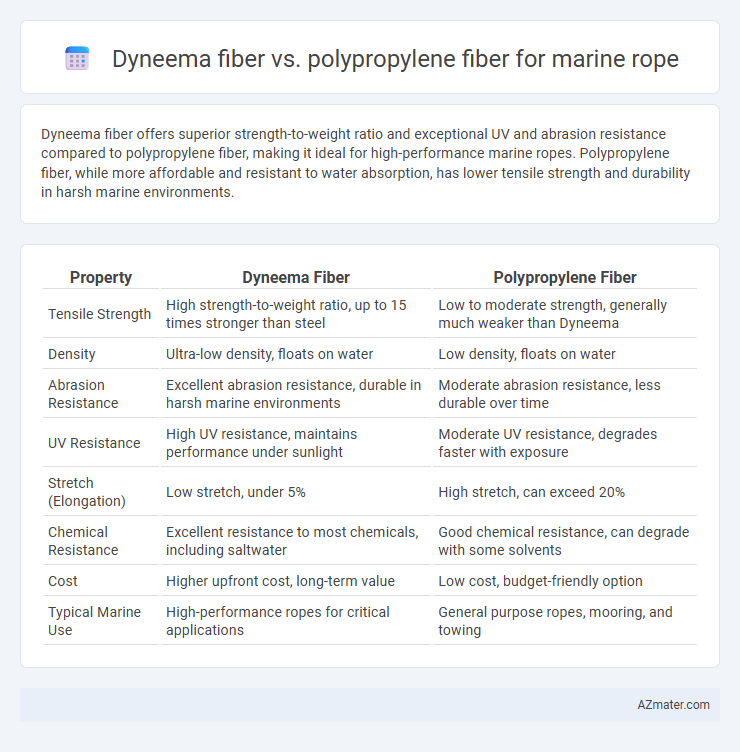Dyneema fiber offers superior strength-to-weight ratio and exceptional UV and abrasion resistance compared to polypropylene fiber, making it ideal for high-performance marine ropes. Polypropylene fiber, while more affordable and resistant to water absorption, has lower tensile strength and durability in harsh marine environments.
Table of Comparison
| Property | Dyneema Fiber | Polypropylene Fiber |
|---|---|---|
| Tensile Strength | High strength-to-weight ratio, up to 15 times stronger than steel | Low to moderate strength, generally much weaker than Dyneema |
| Density | Ultra-low density, floats on water | Low density, floats on water |
| Abrasion Resistance | Excellent abrasion resistance, durable in harsh marine environments | Moderate abrasion resistance, less durable over time |
| UV Resistance | High UV resistance, maintains performance under sunlight | Moderate UV resistance, degrades faster with exposure |
| Stretch (Elongation) | Low stretch, under 5% | High stretch, can exceed 20% |
| Chemical Resistance | Excellent resistance to most chemicals, including saltwater | Good chemical resistance, can degrade with some solvents |
| Cost | Higher upfront cost, long-term value | Low cost, budget-friendly option |
| Typical Marine Use | High-performance ropes for critical applications | General purpose ropes, mooring, and towing |
Introduction to Marine Rope Materials
Dyneema fiber offers exceptional strength-to-weight ratio and superior resistance to UV exposure and abrasion, making it ideal for high-performance marine ropes. Polypropylene fiber is valued for its buoyancy, cost-effectiveness, and chemical resistance but sacrifices tensile strength and durability compared to Dyneema. Marine ropes combining these materials balance performance requirements, with Dyneema preferred for critical load-bearing applications and polypropylene used for general-purpose, floating lines.
Overview of Dyneema Fiber
Dyneema fiber is a high-performance UHMWPE (ultra-high-molecular-weight polyethylene) known for its exceptional strength-to-weight ratio, making it ideal for marine rope applications. It offers superior abrasion resistance, low water absorption, and excellent UV stability compared to polypropylene fiber, enhancing durability and safety in harsh marine environments. Dyneema's low stretch and high tensile strength enable reliable load handling, outperforming polypropylene in critical performance metrics for marine ropes.
Overview of Polypropylene Fiber
Polypropylene fiber is widely used in marine rope due to its lightweight, excellent buoyancy, and resistance to water absorption, making it ideal for floating applications. Its inherent resistance to chemicals, rot, and mildew ensures durability in harsh marine environments, although it offers lower tensile strength and abrasion resistance compared to Dyneema fiber. Polypropylene's affordability and ease of handling make it a cost-effective choice for general-purpose marine ropes, while Dyneema fiber is preferred for high-performance, heavy-duty tasks requiring superior strength and longevity.
Strength and Durability Comparison
Dyneema fiber exhibits exceptional strength-to-weight ratio, outperforming polypropylene fiber by offering up to 15 times greater tensile strength, making it ideal for demanding marine rope applications. Its superior abrasion resistance and low moisture absorption contribute to enhanced durability in harsh marine environments compared to polypropylene, which is more susceptible to UV degradation and water absorption. Dyneema's lightweight and high-performance characteristics ensure longer rope lifespan and reliability, critical for safety and efficiency in marine operations.
Weight and Buoyancy Differences
Dyneema fiber exhibits an exceptionally low density of approximately 0.97 g/cm3, making it lighter than water and granting it excellent buoyancy for marine rope applications. In contrast, polypropylene fiber has a lower density around 0.91 g/cm3, ensuring superior buoyancy as it floats readily on water surfaces. The weight difference significantly impacts marine rope performance, as Dyneema provides high strength-to-weight ratio with minimal water absorption, while polypropylene offers cost-effective buoyancy but lower tensile strength.
Abrasion and UV Resistance
Dyneema fiber exhibits superior abrasion resistance compared to polypropylene fiber, making it highly durable for marine rope applications exposed to frequent friction and rough handling. It also offers excellent UV resistance, retaining strength and flexibility under prolonged sunlight exposure, whereas polypropylene fiber suffers from significant degradation and strength loss when exposed to UV rays. Consequently, Dyneema is preferred for long-lasting marine ropes that must maintain performance in harsh maritime environments.
Water Absorption Characteristics
Dyneema fiber exhibits minimal water absorption, maintaining less than 0.1% moisture uptake, which ensures consistent strength and buoyancy in marine rope applications. Polypropylene fiber, while slightly more absorbent at approximately 0.5%, still offers excellent water resistance but may experience minor strength reduction when wet. The superior hydrophobic properties of Dyneema contribute to enhanced durability and performance in harsh marine environments compared to polypropylene.
Cost and Availability
Dyneema fiber offers unparalleled strength-to-weight ratio and durability for marine ropes, but its high cost and limited availability can be prohibitive for large-scale or budget-sensitive projects. Polypropylene fiber provides an affordable alternative with excellent resistance to water and UV exposure, making it widely accessible and cost-effective for general marine applications. However, polypropylene's lower tensile strength and shorter lifespan compared to Dyneema may require more frequent replacements, impacting long-term cost efficiency.
Common Marine Applications
Dyneema fiber offers superior strength-to-weight ratio and excellent abrasion resistance, making it ideal for high-performance marine ropes used in sailing lines, mooring lines, and fishing nets. Polypropylene fiber is valued for its flotation properties and cost-effectiveness, commonly applied in buoy lines, dock lines, and safety lines where buoyancy and affordability are crucial. Both fibers serve distinct marine applications, with Dyneema preferred for heavy-duty, high-stress environments and Polypropylene favored for lightweight, low-cost floating solutions.
Choosing the Right Fiber for Marine Use
Dyneema fiber offers superior strength-to-weight ratio and exceptional resistance to UV rays, moisture, and abrasion, making it ideal for high-performance marine ropes requiring durability and minimal stretch. Polypropylene fiber excels in flotation and cost-effectiveness, often used for temporary or less demanding marine applications where UV resistance and long-term durability are less critical. Selecting the right fiber depends on the specific marine conditions, with Dyneema favored for heavy-duty, long-lasting tasks and Polypropylene preferred for budget-sensitive or buoyancy-focused uses.

Infographic: Dyneema fiber vs Polypropylene fiber for Marine rope
 azmater.com
azmater.com